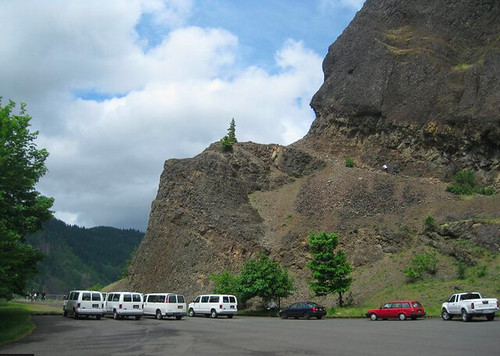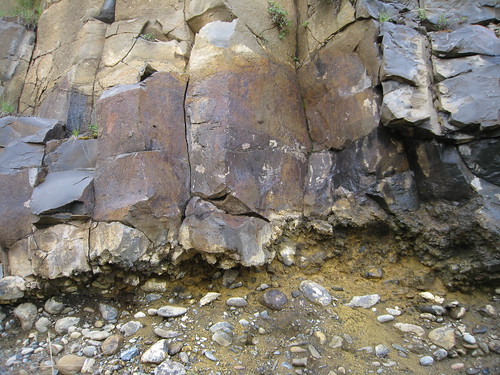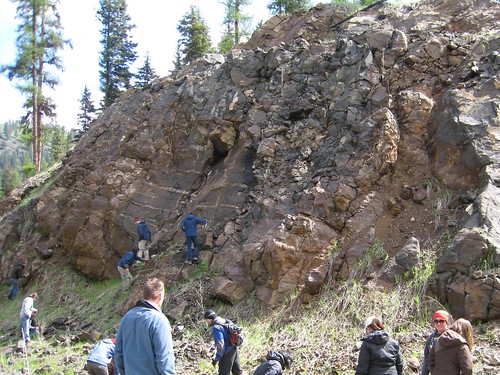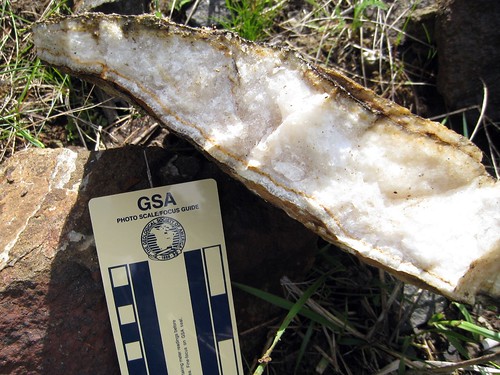Some Eastern Oregon geology fun.
My petrology class recently spent a weekend in the Blue Mountains learning how to hit rocks and write notes in the rain. Okay, so it was a little more than just that. Being a geologist requires the ability to look around and think of things on an incredibly macro scale: area, depth, and (especially) time. Sometimes it's astounding to realize just how big the Earth is... I don't even need the stars to feel insignificant. The beginning of the trip entailed four hours of driving from Portland to La Grande, alongside nothing but Columbia River Basalts. Four hours! You can hardly imagine how much volcanism must have been going on to produce such large deposits.
I'll spend the next few posts describing our field trip and the geology of Eastern Oregon. Click here for a Google Earth (best freeware ever made!) map of the first nine stops.
Stop 1
Observations: A large, well-formed columnar basalt layer had been deposited over a layer of rounded cobbles and clay. The basalt contains a lot of vesicles and olivine phenocrysts, while the cobbles are mostly Columbia River Basalts (CRB) and various metamorphic rocks. The border between the two strata is rough and contains palagonite, an indication of altered glass. (This is unusual! Basalt has such a low viscosity that it doesn't normally prefer to create glass.)
The outcrop is nestled in a valley with Grande Ronde Basalt (dated at 15 Ma) on either side and the modern Grande Ronde River flowing nearby. Its surrounding rocks are distinctly different, most noticeably by the absence of olivine phenocrysts.
Interpretations: After the Grande Ronde basalt was formed about 15 million years ago, a river cut through the rock and created a valley. The cobbles match metamorphic rocks associated with Oregon's mass amounts of accreted terrane, so they were probably eroded and carried down the river from a highland outcrop somewhere nearby. Around 10 Ma, a basalt lava flow (maybe from the Powder River Volcanics?) suddenly filled in the valley and was allowed to cool slowly and cohesively, giving it distinct columnar jointing and a high density. The hot lava interacted with the river water to create glass, which is why we found palagonite present at the contact zone.
Stop 2
Observations: There are coarser, crystalline rocks that form bands within a basaltic mass. The thinner bands have more vesicles but are texturally similar. The banding does not show any evidence of chilled margins, indicating that it was not a sill intrusion. Nicely-formed quartz and calcite veins solidified in the cooling cracks of the basalt.
Interpretations: This basalt flow is probably older than the CRBs since the growth of quartz and calcite as secondary minerals would have taken longer to form. Basalt can contain up to 10% calcium, so weathering processes likely caused the calcite to precipitate into cracks that formed as it was cooling. Later, hydrothermal fluids rising through the cracks would have carried dissolved SiO2 and created the quartz veins. This outcrop is estimated to have formed at around 28 Ma.
TO BE CONTINUED...
6.04.2011
Subscribe to:
Post Comments (Atom)





No comments:
Post a Comment